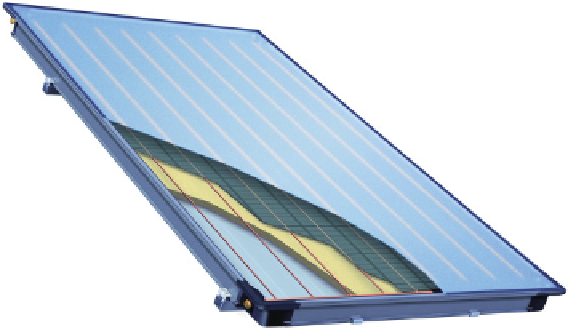Environmental Engineering Reference
In-Depth Information
6.2.2 Flat-Plate Collectors
With fl at-plate collectors a front panel of glass reduces heat loss considerably.
Unfortunately, the front glass also refl ects some of the sunlight. Therefore, when
collector temperatures are very low, the effi ciency of a swimming pool absorber can
be higher than that of a fl at-plate collector. However, fl at - plate collector effi ciency
increases considerably as temperatures rise.
In summer there are times when solar thermal systems do not need any heat. For
example, when a heat storage cylinder is completely full the system does not pump
any more water through the collector. This is referred to as a collector standstill.
The temperatures in collectors can easily rise above 100°C. Very good fl at - plate
collectors reach standstill temperatures between 150 ° C and 200 ° C. This therefore
rules out the use of plastic pipes for absorbers. The absorbers of fl at - plate collectors
usually consist of copper pipes fi xed to a thin metal plate (Figure 6.4). The absorber
itself is located in a collector enclosure that is well insulated at the back to minimize
rear heat loss.
Figure 6.4
Cross-section of a fl at-plate collector.
Picture: BBT Thermotechnik GmbH.
Metallic materials by nature do not have a black surface that absorbs the sun's
radiation well, so they need to be coated. The fi rst option that is usually considered
for the coating is black paint. Although temperature-resistant black paint is good
for this purpose, there are other far better materials for absorber coating. When a
black surface gets warm, it sends out some of the heat energy in the form of thermal
radiation. This can be observed with an electric hot plate that has been switched on.
One can feel the heat radiating from the hot plate without even touching it. The
same effect occurs with a black-painted absorber. The absorber only radiates part
of its heat to the water fl owing through. Another part is emitted back into the envi-
ronment as undesirable thermal radiation.
Thermal radiation losses can be minimized through the use of selective coatings
(Figure 6.5). These coatings absorb the sunlight just as well as a black-painted plate.

